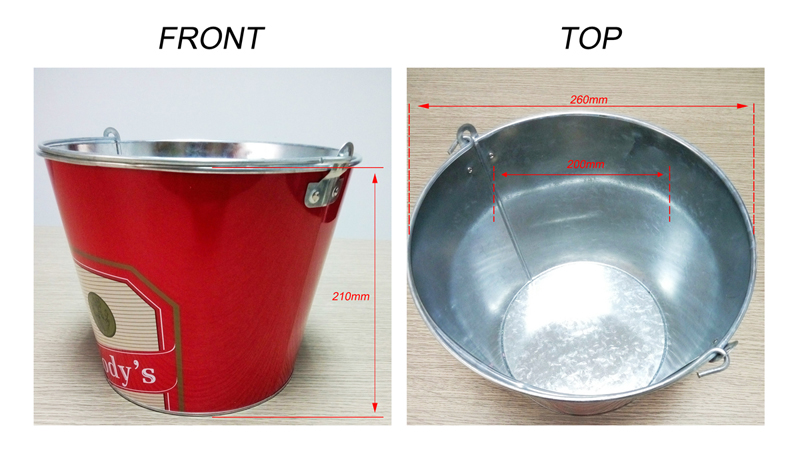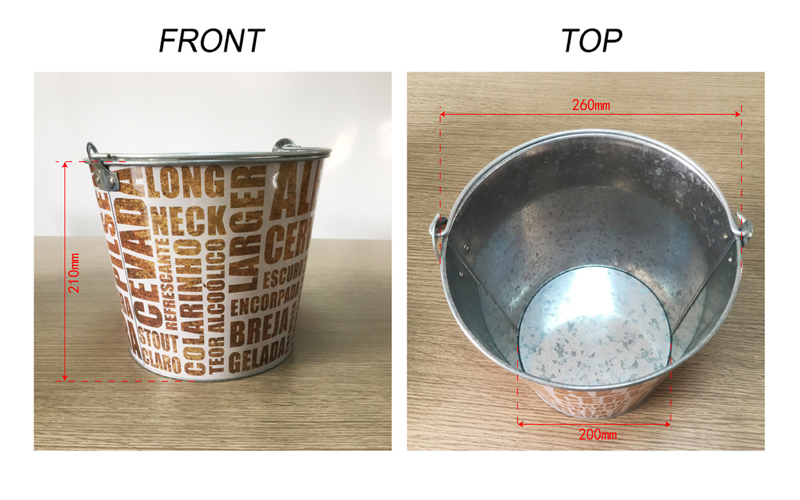8QT Ice Bucket:
We have provided custom beer kegs for Coca-Cola, Corona,
Carlsberg, etc. The sizes of the ice buckets are 5QT, 7.5QT, 10QT and
15QT and so on. The round ice buckets are small and portable, with
various types of handles and bottle openers, and simple operation.
Description of the 8QT ice bucket:
Name:8QT ice bucket
Spec:Φ260/Φ200×210mm
Material: galvanized iron
Note: can hold 8 beer bottles of 355ml
Fields of applications: bar, party, hotel, home, outdoor activity
1.Are you factory ?
Yes. A professional ice bucket and Tin Tray manufacture.
2.Are your products the lowest prices ?
EXW, the same quality, we are much cheaper than other suppliers.
3.Can we customized product ?
Yes, Tailor-made tooling for your own design is welcome.
4.What is the transportation ?
If small quantity, we suggest that sent by Courier, If large amount, by
shipping.
5.If goods are damaged in transit, how to do ?
Products are inspected strictly before shipping, if damage, they can be
replaced .
8Qt Ice Bucket,Plastic Ice Bucket,Wine Plastic Ice Bucket,Ice Bucket Tin Box True & Bright Metal Packaging Co.,Ltd.KaiPing , https://www.tnbcan.com


Human cholecystokinin/Cholecystokinin octapeptide (CCK-8) enzyme-linked immunosorbent assay (ELISA) kit instruction manual
This reagent is for research use only: This kit is used to determine the content of cholecystokinin/cholecystoxin octapeptide (CCK-8) in human serum, plasma and related liquid samples. Experimental principle: This kit uses the double antibody sandwich method to determine the level of human cholecystokinin/cholecystoxin octapeptide (CCK-8) in the specimen. The microporous plate was coated with purified human cholecystokinin/cholecystokinin octapeptide (CCK-8) antibody to prepare a solid phase antibody, and cholecystokinin/cholecystoxin octapeptide was sequentially added to the micropores of the coated monoclonal antibody. (CCK-8), and then combined with HRP-labeled cholecystokinin/Cholecystokinin octapeptide (CCK-8) antibody to form an antibody-antigen-enzyme-labeled antibody complex, which was thoroughly washed and then added with substrate TMB for color development. TMB is converted to blue under the catalysis of HRP enzyme and converted to the final yellow color by the action of an acid. The color depth is positively correlated with cholecystokinin/cholecystoxin octapeptide (CCK-8) in the sample. The absorbance (OD value) was measured with a microplate reader at a wavelength of 450 nm, and the concentration of human cholecystokinin/cholecystoxin octapeptide (CCK-8) in the sample was calculated from a standard curve. Sample processing and requirements: 1. Serum: room temperature blood is naturally coagulated for 10-20 minutes, centrifuged for about 20 minutes (2000-3000 rpm). The supernatant is carefully collected, and if precipitation occurs during storage, it should be centrifuged again. 2. Plasma: EDTA or sodium citrate should be selected as an anticoagulant according to the requirements of the specimen. After mixing for 10-20 minutes, centrifuge for about 20 minutes (2000-3000 rpm). The supernatant is carefully collected, and if a precipitate forms during storage, it should be centrifuged again. 3. Urine: Collect with a sterile tube and centrifuge for about 20 minutes (2000-3000 rpm). The supernatant is carefully collected, and if a precipitate forms during storage, it should be centrifuged again. The chest and ascites and cerebrospinal fluid are referred to. 4. Cell culture supernatant: When detecting secreted components, collect them in a sterile tube. Centrifuge for about 20 minutes (2000-3000 rpm). Collect the supernatant carefully. When the components in the cells were detected, the cell suspension was diluted with PBS (pH 7.2-7.4), and the cell concentration reached about 1 million/ml. By repeated freezing and thawing, the cells are destroyed and the intracellular components are released. Centrifuge for about 20 minutes (2000-3000 rpm). Collect the supernatant carefully. If a precipitate forms during storage, it should be centrifuged again. 5. Tissue specimen: After cutting the specimen, weigh the weight. Add a certain amount of PBS, pH 7.4. It was quickly frozen and stored in liquid nitrogen for use. The specimen still maintains a temperature of 2-8 ° C after melting. A certain amount of PBS (pH 7.4) was added, and the specimen was homogenized by hand or homogenizer. Centrifuge for about 20 minutes (2000-3000 rpm). Collect the supernatant carefully. One part of the package is to be tested, and the rest is frozen for use. 6. The specimens should be extracted as soon as possible after collection, and the extraction should be carried out according to the relevant literature. The experiment should be carried out as soon as possible after extraction. If the test cannot be performed immediately, the specimen can be stored at -20 °C, but repeated freezing and thawing should be avoided. 7. Samples containing NaN3 cannot be detected because NaN3 inhibits horseradish peroxidase (HRP) activity.